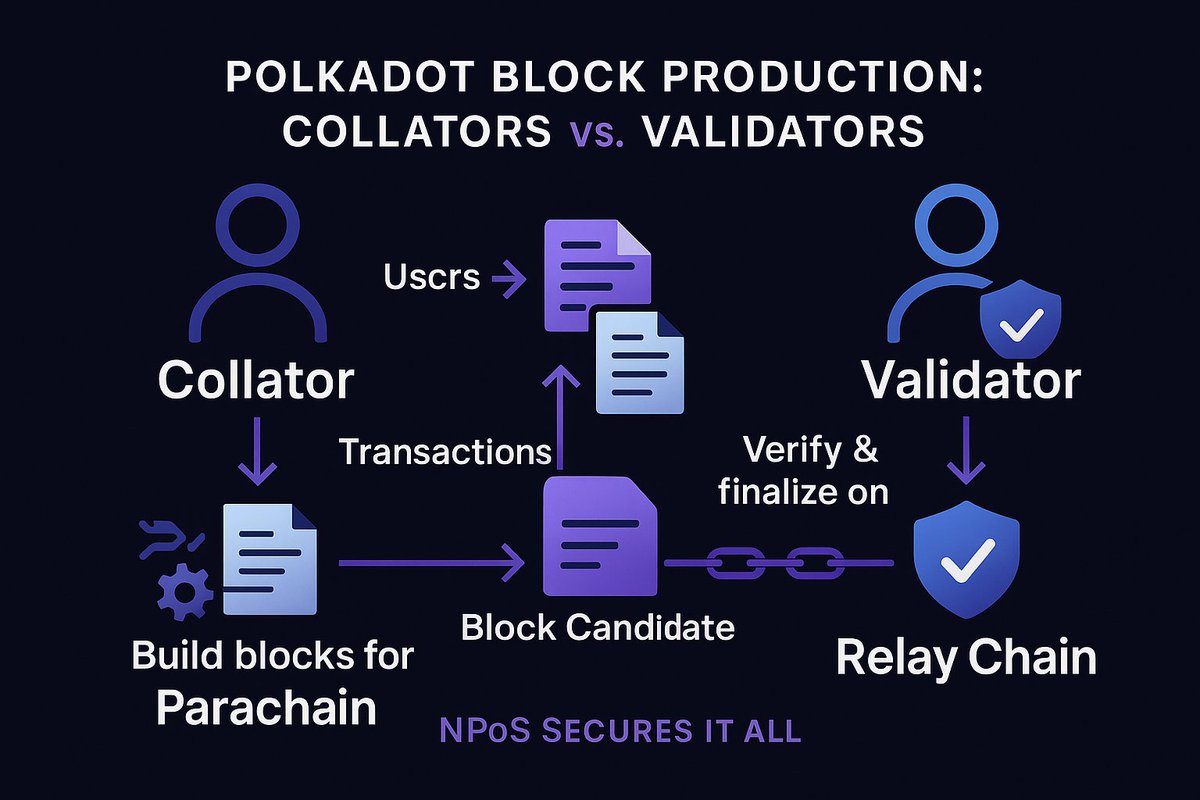[GUEST ACCESS MODE: Data is scrambled or limited to provide examples. Make requests using your API key to unlock full data. Check https://lunarcrush.ai/auth for authentication information.]  Crypto Ninja [@CryptoNinjaPlus](/creator/twitter/CryptoNinjaPlus) on x XXX followers Created: 2025-07-25 13:34:04 UTC 🧠 Context: Collators vs. Validators: Who Really Runs the Blockchain? In blockchain ecosystems like Polkadot, scalability and security depend on two unsung heroes: collators and validators. Their collaboration enables efficient block production and finality within Proof-of-Stake systems. 🔍 Explanation: Collators operate parachain full nodes, aggregating user transactions and constructing “block candidates.” While they don’t finalize these blocks, they optimize throughput and responsiveness by preparing them for validation. Think of them as the data pipeline that feeds the consensus engine. Validators take over next. Backed by staked $DOT via NPoS, they verify collators’ proposals and vote to finalize blocks. They enforce consensus rules, slash malicious actors, and secure the shared Relay Chain. This separation of duties—collators preparing data, validators verifying integrity—boosts performance while maintaining decentralization and trust. Validators are rewarded for securing the chain, while collators ensure quick block availability across parachains. ✅ Key Takeaways: -Collators: Assemble transactions, propose blocks. -Validators: Verify, finalize, and secure the network. -Separation = speed + trust. -Together, they enable scalable, forkless upgrades. -Fundamental to Polkadot’s multichain design. 📣 The Takeaway: Collators and validators don’t just power Polkadot—they represent the next evolution of secure, scalable blockchain infrastructure. Could this be the model for all future PoS networks? 👇 Drop your thoughts below! #Polkadot #Crypto #Web3 @Polkadot  XXX engagements  **Related Topics** [blockchain](/topic/blockchain) [ninja](/topic/ninja) [Post Link](https://x.com/CryptoNinjaPlus/status/1948738525253476820)
[GUEST ACCESS MODE: Data is scrambled or limited to provide examples. Make requests using your API key to unlock full data. Check https://lunarcrush.ai/auth for authentication information.]
 Crypto Ninja @CryptoNinjaPlus on x XXX followers
Created: 2025-07-25 13:34:04 UTC
Crypto Ninja @CryptoNinjaPlus on x XXX followers
Created: 2025-07-25 13:34:04 UTC
🧠 Context: Collators vs. Validators: Who Really Runs the Blockchain?
In blockchain ecosystems like Polkadot, scalability and security depend on two unsung heroes: collators and validators. Their collaboration enables efficient block production and finality within Proof-of-Stake systems.
🔍 Explanation: Collators operate parachain full nodes, aggregating user transactions and constructing “block candidates.” While they don’t finalize these blocks, they optimize throughput and responsiveness by preparing them for validation. Think of them as the data pipeline that feeds the consensus engine.
Validators take over next. Backed by staked $DOT via NPoS, they verify collators’ proposals and vote to finalize blocks. They enforce consensus rules, slash malicious actors, and secure the shared Relay Chain. This separation of duties—collators preparing data, validators verifying integrity—boosts performance while maintaining decentralization and trust. Validators are rewarded for securing the chain, while collators ensure quick block availability across parachains.
✅ Key Takeaways: -Collators: Assemble transactions, propose blocks. -Validators: Verify, finalize, and secure the network. -Separation = speed + trust. -Together, they enable scalable, forkless upgrades. -Fundamental to Polkadot’s multichain design.
📣 The Takeaway: Collators and validators don’t just power Polkadot—they represent the next evolution of secure, scalable blockchain infrastructure. Could this be the model for all future PoS networks?
👇 Drop your thoughts below! #Polkadot #Crypto #Web3 @Polkadot

XXX engagements
Related Topics blockchain ninja